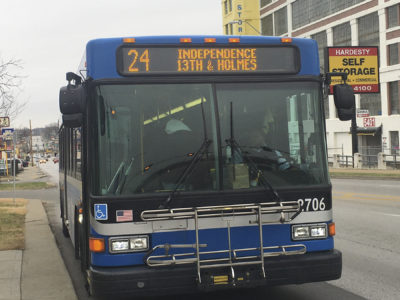Katrina E. Williams
Northeast News
The Kansas City Area Transportation Authority is conducting a study of the Independence Avenue corridor to determine if it could support a MAX bus rapid transit line. According to Shawn Strate, Planning Manager of the Kansas City Area Transportation Authority, the study is in the initial planning stages.
“This week is when our consultant team is beginning the initial tasks of reviewing existing plans, collecting data, and analyzing existing transit and corridor conditions,” Strate said. “The study will become more publicly visible in February as we start forming an advisory committee and advertising public meetings. It will be completed by the end of the year.”
The RideKC MAX line primarily serves highly populated residential and commercial areas. According to the KCATA website, it offers improved services over regular bus lines, with features including more frequent pickups, well-lit and highly visible MAX bus stations, fewer stops, and traffic signal priority. Additionally, the MAX service offers real-time information updates to let riders know precise arrival times.
“Our previous MAX investments have also proven to have economic development and crime-reduction value, as well,” Strate added.
The first MAX bus line appeared in 2005, as the “Main MAX.” When that proved successful, a second corridor was added on Troost. Currently, there are plans to implement this service along Prospect Ave., into downtown KCMO. The development of the Prospect route is on a six-year timeline, though some of that has been delayed due to lack of funding. The Independence Avenue study could help move this process forward, but funding remains a key issue.
“Ridership is also fairly evenly distributed along Independence Avenue, as opposed to concentrated in one or two locations, which might suggest a different type of bus service,” Strate said.
One option the KCATA is looking into for funding relief is a Small Starts grant from the Federal Transportation Administration, which requires a study to be completed.
“The study will review if MAX service makes sense for Independence Avenue and define the next steps for implementation. The study includes a lot of technical analysis relating to travel time testing, determining appropriate bus stop locations and configuration, and an evaluation of ridership demand,” Strate added. “It also includes working with community stakeholders and the general public to get input, ideas, and support.”
The study also aims to gauge community support for an Independence Avenue MAX to help spur the funding for the line, Strate urged stakeholder involvement.
“In the very near term, participation in this study is key,” he said. “We will be building an advisory committee comprised of community leaders, and the general public will be invited to participate in public meetings, workshops, and open houses. The study cannot reasonably recommend MAX service without community support, and a strong indication that people will use and benefit from the service.”

















